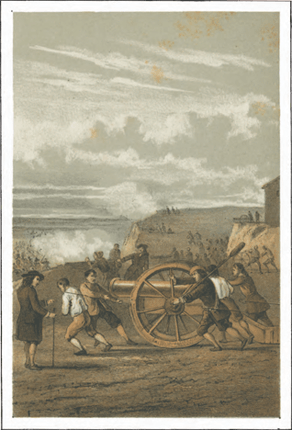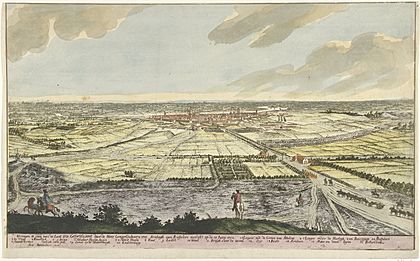Assault on Nijmegen (1702) facts for kids
Quick facts for kids Assault on Nijmegen |
|||||||
|---|---|---|---|---|---|---|---|
| Part of the War of the Spanish Succession | |||||||
 Citizens of Nijmegen operating the artillery to defend the city |
|||||||
|
|||||||
| Belligerents | |||||||
| Commanders and leaders | |||||||
| Strength | |||||||
| 37 battalions 59 squadrons 25,000-40,000 men |
27 battalions 62 squadrons 21,000-23,000 men Nijmegen garrison: 2 battalions |
||||||
| Casualties and losses | |||||||
| 200-300 killed or wounded | 700-1,000 killed, wounded or captured | ||||||
The Assault on Nijmegen was a short but important event during the War of the Spanish Succession. It happened on June 10 and 11, 1702. French troops, led by the Duc de Boufflers, tried to capture the city of Nijmegen.
Nijmegen was defended by a small group of soldiers and brave citizens. An Anglo-Dutch army, led by the Earl of Athlone, also helped protect the city. The French attack was an attempt to save another city, Kaiserswerth, from being captured by the Allies.
Boufflers hoped to trick Athlone's army into a big battle. He wanted to pull them away from their strong defensive spot. But the plan didn't work. The French couldn't take Nijmegen. They also failed to force Athlone's army into a major fight.
Why the Attack Happened: The Prelude
In May 1702, a big war began in Europe. It was called the War of the Spanish Succession. The Dutch Republic, England, and the Holy Roman Emperor declared war on France.
French troops had already moved into areas like the Spanish Netherlands and Germany. This put them very close to the Dutch border. To protect their eastern side, the Allies began a siege (a military blockade) of Kaiserswerth on April 18.
An Anglo-Dutch army, led by the Earl of Athlone, was camped near Kranenburg. They had a strong defensive position. The French army, led by Boufflers, was camped nearby.
By early June, the defenders in Kaiserswerth were in trouble. Boufflers wanted to make one last effort to save Kaiserswerth. He decided to attack Nijmegen as a surprise. He hoped this would force Athlone to leave his strong position and fight.
Nijmegen was a very important Dutch city. It had new defenses designed by Menno van Coehoorn. But it only had two groups of soldiers, called battalions. The city was not ready for a sudden French attack. If Athlone stayed put, Nijmegen might have fallen easily.
The French Attack on Nijmegen
The French attack was a surprise, but not completely unexpected. There had been rumors that something was coming. On the morning of June 10, news reached the Anglo-Dutch camp. The French army, with the Duke of Burgundy (who was the heir to the French throne), was on the move.
Still, Athlone's army stayed in their camp until 8 PM. Finally, they decided they had to retreat. Their cannons and supplies were sent towards Nijmegen first. The foot soldiers followed, and the cavalry (soldiers on horseback) took another route. Athlone also sent four battalions to another city, Grave, just in case.
On the morning of June 11, the cavalry from both sides saw each other. French cavalry tried to slow down the Allied retreat. But soon, the French realized that Athlone's entire army was marching towards Nijmegen. The French cavalry followed closely but didn't attack without their own foot soldiers.
By 1 PM, Athlone's army reached the outer defenses of Nijmegen. The Anglo-Dutch foot soldiers took positions in the hidden pathways. The cavalry stood on the open slopes outside the walls.
For several hours, the armies faced each other. There wasn't a huge battle. There were some small fights between cavalry groups. Cannons also fired back and forth. The French used their field cannons. The Dutch citizens of Nijmegen used cannons they found in a storehouse. They brought them to the city walls and fired them themselves!
The city was so unprepared that at first, there were no cannons or trained gunners on the walls. It even took a long time to find the keys to the cannon storehouse. But the citizens' bravery was later highly praised. A fort called 'Kijk in de Pot' was captured twice by French cavalry but taken back both times.
Around 5 PM, Boufflers and the Duke of Burgundy decided to retreat. They were under fire from Nijmegen's cannons. They also couldn't force Athlone from his strong position.
What Happened Next: The Aftermath
The Allies lost more soldiers than the French in these skirmishes. About 700 Allied soldiers were killed, wounded, or captured. The French lost around 200. The French also captured 300 supply wagons that the Allies couldn't protect.
Because of this, the French said the attack on Nijmegen was a big success for them. The Duke of Burgundy was even praised for his actions. But in reality, the operation was a failure. The French couldn't take Nijmegen. They also couldn't force Athlone into a major battle. Most importantly, they failed to break the siege of Kaiserswerth. Just a few days after the attack on Nijmegen, Kaiserswerth surrendered to the Allies.
Boufflers had been careful during the attack. This was partly because the Allies showed strong determination. A writer named the Marquis de Quincy later wrote that two cavalry groups, one English and one Danish, were very brave. They stood firm even under cannon fire.
Historian Jan Willem Wijn said that the retreat to Nijmegen showed how good the Dutch-English army was. Many times in history, a retreat under enemy pressure turns into a panicked escape. But this one didn't.
Boufflers himself received some criticism. Some people said he was too cautious. The Duke of Berwick believed that too much talking and thinking stopped the French from taking Nijmegen. It's possible that having France's future king there made Boufflers extra careful.
On June 25, Marlborough became the main commander of the Anglo-Dutch army. The armies of Athlone and Nassau-Usingen joined together. More troops arrived from England and Germany. Marlborough now had 60,000 men.
He used this strong force to go on the attack. He moved into the Spanish Netherlands. Marlborough followed the Meuse river, just like Frederick Henry had done in 1632. Rivers were very important for moving army supplies back then. Roads were not very good.
The Allies captured several forts along the Meuse river. These included Venlo, Stevensweert, Roermond, and Liège. So, the year ended well for the Allies. Even though the French lost these forts, the main defense lines of the Spanish Netherlands were still strong.


